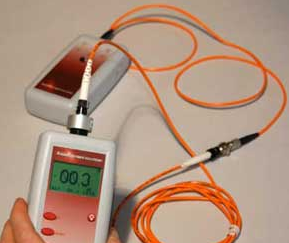- Related articles
- All Cisco DS-X2-FC10G-SR's information (List price, Specs, Datasheet PDF, Compatibility ma
- The overview of bus standard from PCI Express 1.0 to 3.0
- Optical Transceivers for Cisco SG350XG-48T-K9-UK Switch
- What is 1000BASE Transceiver?
- Optical Transceivers for Cisco N5548UPM-6N2248TP Switch
- All Cisco X2-10GB-ER's information (List price, Specs, Datasheet PDF, Compatibility matrix
- All Cisco DWDM-XENPAK-50.92's information (List price, Specs, Datasheet PDF, Compatibility
- Applicable to 1000BASE-SX Standard Optical Transceiver Models
- The Things You Need to Know about 10GBASE-SW Ethernet Standards
- Installation of Pipe Fiber Optic Cable

Introduction
It is very important to test the fiber optic cable so as to know its condition. Some may be broken from inside and therefore they can’t be used while others are in good condition. The fiber optic cables are widely tested using an economical fiber optic power meter that is designed purposely for that function. The power meter provides accurate results.
Fiber testing
After the cables are installed and terminated, it's time for testing. For every fiber optic cable plant, you will need to test for continuity, end-to-end loss and then troubleshoot the problems. If it's a long outside plant cable with intermediate splices, you will probably want to verify the individual splices with an OTDR also, since that's the only way to make sure that each one is good. If you are the network user, you will also be interested in testing power, as power is the measurement that tells you whether the system is operating properly.

You'll need a few special tools and instruments to test fiber optics.
Note: You need to know what we mean when we say “accurate” – that the measurement made gives a value close to the “real” value. Another term often misunderstood is "precision" which means if you make the same measurement over and over, you get the same value, but that value may not be accurate. Standards people prefer to talk about the “uncertainty” of the measurement because it’s practically impossible to know what the real value is, but it is possible to determine how much error is likely in any given measurement. With apologies to those people, I’m going to use the term accuracy because everyone uses it more commonly.
The customer for a fiber optic cable installation will require documentation of test results before accepting and paying for the work. This obviously leads to certain but often conflicting requirements on the part of the contractor doing the installation. Testing takes time, so completing all the tests in the minimum time means more profit. Testing, however, needs to be done carefully to ensure the measurements are accurate, and that can take time. Accurate testing, however, will ensure that no good cables are rejected and no bad ones missed, so the contractor will not have to repair what are really good cables and get callbacks on bad ones.
Conclusion
The Fiber power meter has brought great relieve in the fiber industry since now the Fiber Optic Cables are tested before transaction is done. People now can test the accuracy of the cable before paying for it therefore, reducing the chances of being conned.





































































